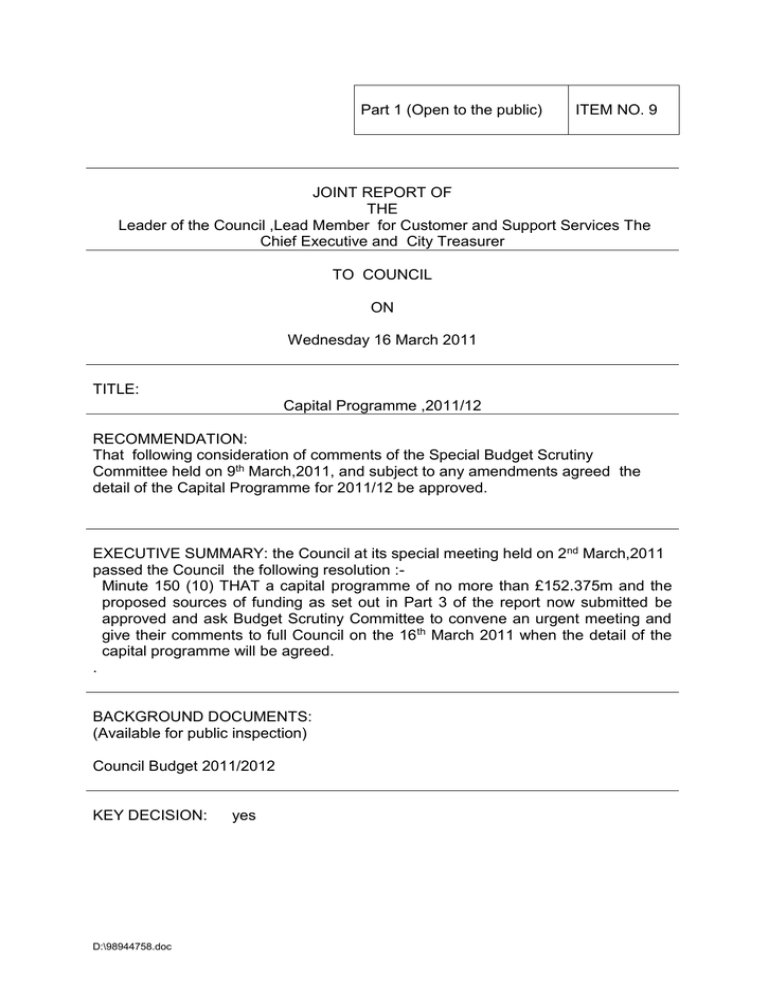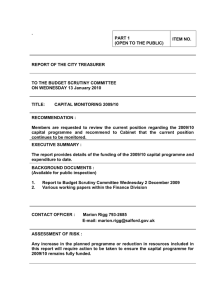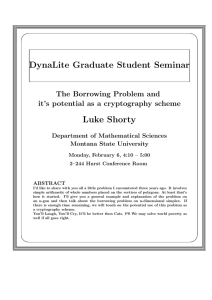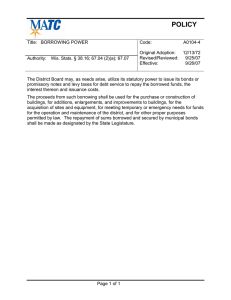Part 1 (Open to the public) ITEM NO. 9 JOINT REPORT OF
advertisement

Part 1 (Open to the public) ITEM NO. 9 JOINT REPORT OF THE Leader of the Council ,Lead Member for Customer and Support Services The Chief Executive and City Treasurer TO COUNCIL ON Wednesday 16 March 2011 TITLE: Capital Programme ,2011/12 RECOMMENDATION: That following consideration of comments of the Special Budget Scrutiny Committee held on 9th March,2011, and subject to any amendments agreed the detail of the Capital Programme for 2011/12 be approved. EXECUTIVE SUMMARY: the Council at its special meeting held on 2nd March,2011 passed the Council the following resolution :Minute 150 (10) THAT a capital programme of no more than £152.375m and the proposed sources of funding as set out in Part 3 of the report now submitted be approved and ask Budget Scrutiny Committee to convene an urgent meeting and give their comments to full Council on the 16 th March 2011 when the detail of the capital programme will be agreed. . BACKGROUND DOCUMENTS: (Available for public inspection) Council Budget 2011/2012 KEY DECISION: D:\98944758.doc yes DETAILS: The comments of the Budget Scrutiny Committee are set out below After detailed consideration, Budget Scrutiny Committee were able to accept the assumptions made in the build up of the 2011/12 Capital budget, and made the following specific conclusions and recommendations for Council’s consideration : The Capital Programme and Capital Investment Strategy reflect the priorities of the leading political group. The Capital Programme is resourced appropriately. The proposed level of unsupported borrowing is affordable and consistent with the 2011/12 Revenue Budget. The associated risks have been adequately recognised and allowed for in the Capital Programme 2011/12. That the Capital programme continues to be monitored by Budget Scrutiny Committee throughout the year. With regard to these points, opposition parties reserved the right to form different views on the budget proposals. KEY COUNCIL POLICIES: Council Constitution EQUALITY IMPACT ASSESSMENT AND IMPLICATIONS: Equality impact assessment will carried out in to budget implementation ASSESSMENT OF RISK: High the capital programme detail needs to be approved to conclude the Councils budget deliberations for 2011/12 SOURCE OF FUNDING Capital Budget LEGAL IMPLICATIONS Supplied by N/a FINANCIAL IMPLICATIONS Supplied by City Treasurer OTHER DIRECTORATES CONSULTED: All Strategic Directors and Lead Members have been involved in the preparation of the 2011/12 Capital Programme. D:\98944758.doc CONTACT OFFICER John Spink City Treasurer TEL. NO. 793 3230 WARD(S) TO WHICH REPORT RELATE(S): all D:\98944758.doc CAPITAL INVESTMENT STRATEGY 2011/12 TO 2014/15 and CAPITAL PROGRAMME 2011/12 D:\98944758.doc THE PRUDENTIAL CODE FOR CAPITAL FINANCE 1.1. In considering the capital programme, due regard needs to be given to the implications of the new prudential capital finance system, which became operative on 1st April 2004 under the Local Government Act 2003, and is guided by CIPFA’s Prudential Code for Capital Finance. 1.2. The key principle behind the new system is that any capital expenditure plans must be affordable. In particular, local authorities will have the freedom to determine the amount of new borrowing it will undertake, subject to the capital financing costs being affordable in the revenue budget. 1.3. To reflect this freedom, the Government abolished the system of credit approvals and replaced it with amounts of borrowing that it will support through RSG. For 2011/12 it has gone further and will in future only give support through capital grant and not through supported borrowing. 1.4. Whilst this still imposes a form of constraint on borrowing, there is now more freedom for local authorities to determine their own borrowing, providing they can afford to meet the capital financing costs from their revenue budget. 1.5. Also, capital planning over longer timescales is better facilitated as the timing of capital receipts is less critical and borrowing can be used to regulate any delays in completion of disposals at year-end, provided any resulting temporary extra debt is repaid from the capital receipt. 1.6. Borrowing to fund invest to save or self-financing proposals is now also a realistic proposition, provided a business case is made that savings through efficiency or income can meet the capital financing costs of the borrowing. 1.7. As far as funding capital expenditure from borrowing is concerned, Council previously agreed, in February 2004, the following principles : Borrowing will only exceed the amount supported by Government in prescribed circumstances. The prescribed circumstances will be : - invest to save or self-financing proposals where a business case has been approved by the Lead Member for Corporate Services (now Customer and Support Services) which provides for revenue savings at least equivalent to the capital financing costs of the borrowing ; - where a capital receipt expected and built into financing plans in a financial year is delayed until the following financial year, provided the borrowing is repaid by the capital receipt in the following year ; D:\98944758.doc - where Government grant is certain or expected with a high degree of confidence and it is essential that expenditure is committed ahead of the grant being approved or paid, in order to maximise the amount available. 1.8. These principles continue to remain valid and form the core of the mediumterm financial strategy. 1.9. However, to sustain the capital investment demands which the Council currently has, and bearing in mind the impact which the current economic climate is having upon the ability to generate capital receipts that represent fair value, consideration has needed to be given to an additional principle of using unsupported borrowing on a temporary basis until value returns to the market for asset disposal. 1.10. Unsupported borrowing will now be the primary source of the Council generating its own resources towards funding capital investment, with capital receipts being used to repay debt as and when asset disposals can be realised and give fair value. 1.11. Limits and conditions will be set for the use of unsupported borrowing as follows : That capital receipts are applied in the first instance to repay debt when they are received ; That an absolute ceiling is placed upon the total value of unsupported borrowing in use in any financial year where it has been used to temporarily replace capital receipts, and that annual ceiling should be £30m (Note : unsupported borrowing used on an invest to save or self-financing basis would be treated as long-term borrowing funded from revenue savings and therefore be excluded from this ceiling) ; That the use of unsupported borrowing is affordable in revenue terms ; That short-term borrowing is used as the basis of the unsupported borrowing so that when capital receipts do come in the associated debt can be repaid on their natural maturity dates without incurring any premium chargeable to revenue. 1.12. It will be necessary to continue to use unsupported borrowing to provide the necessary resource in 2011/12 to deliver a fully funded capital programme that delivers the desired priority outcomes. 1.13. Furthermore, because the new prudential system requires a chief financial officer to recommend prudential borrowing indicators to the Council, the determination of the capital programme needs to be aligned with the revenue budget by considering and approving them at the same Council meeting. D:\98944758.doc 2. REVIEW OF 2010/11 2.1. A capital programme of £143.966m for 2010/11 was originally approved by Council last February, funded by Government grant of £83.717m, supported borrowing of £7.671m, unsupported borrowing of £49.487m and other contributions of £3.091m. 2.2. There have been variations to the programme as new schemes with Government grant funding have been approved. All programme adjustments have been agreed with the Lead Member for Customer and Support Services and reported to Budget Scrutiny Committee. 2.3. Based on the latest capital monitoring report to Budget Scrutiny Committee (February 2010) outturn capital expenditure is expected to be £155.973m. funded by Government grant of £85.058m, supported borrowing of £12.366m, unsupported borrowing of £52.960m and other contributions of £5.589m. 2.4. The use of unsupported borrowing is split as follows :Self-Financing/Invest to Save HRA capital expenditure - general support General Fund capital expenditure - general support £m 10.812 7.730 34.418 2.5. The capital financing costs of the unsupported borrowing have been factored into the revenue budget. 3. CAPITAL INVESTMENT STRATEGY 2011/12 TO 2014/15 Regeneration 3.1. Regeneration is at the heart of the Council’s priorities for capital investment and housing development forms an integral part of an integrated strategy to regenerate Central Salford, including the areas of major housing change in Ordsall, Lower and Higher Broughton, Seedley and Langworthy and Charlestown/Kersal, together with other key parts of the City such as Mediacity, Chapel St, Greengate and Salford West, which have more of a commercial and economic emphasis. 3.2. Several major developers, house builders and financial institutions are investing within the City and working in partnership with the Council. This creates a new and key challenge for the Council to integrate resources and programmes effectively and to gear the use of the Council’s own resources clearly to meet the objectives of stimulating other investment to promote the regeneration of the City and better services. 3.3. Increasingly in recent years, the Council has relied on funding from the Government via grants from NWDA, HCA and English Partnerships, from special funding such as the Housing Market Renewal (HMR) Pathfinder, New D:\98944758.doc Deal and PFI, but seeks to add value by the use of its own resources. The funding landscape has changed with the election of the coalition Government last year. Funding sources such as NWDA and HMRF will cease and HCA and PFI funding has been curtailed significantly, but other new potential funding sources, such as Regional Growth Fund, Evergreen and the Local Sustainable Transport Fund. 3.4. Due to the ceasing of NWDA and reduction in HCA funding, the Central Salford Urban Regeneration Company (URC) will be wound up on 31st March 2011, although the residual programme will continue under the Council’s management. 3.5. Salix Homes is now on the Government’s approved decent homes programme following its successful 2-star inspection rating last year, whilst Government has confirmed that the PFI scheme for 2,000 properties in Pendleton has survived national reductions in PFI schemes. 3.6. The Unitary Development Plan and Greater Manchester Local Transport Plan set out the transport priorities for the City and wider conurbation. The policies contained in these documents focus on safety, sustainability and regeneration whilst conforming to planning policy and regional planning guidance. There has been a significant reduction in Government capital funding nationally for Transport. Schools 3.7. The Education Asset Management Plan (AMP) sets out the need to provide high quality education in accommodation that stimulates a learning environment for school pupils and members of the community. 3.8. The Council’s capital programme for schools is largely driven by major Government funding initiatives through the Building Schools for the Future (BSF) programme for improvement in secondary school conditions and supported borrowing and grant to improve primary school conditions. 3.9. The Council has been successful in gaining Government approval with its BSF submission and is on site with phase 1 at Walkden and Irlam and Cadishead High Schools aiming to be open in September 2011, although the timing of phases 2 and 3 will depend on the outcome of negotiations with the Government on reduced PFI funding. 3.10. A primary school capital programme aims to remove surplus places and reduce the backlog of poor condition in response to the provision of major Government funding. However, the announcement by the Government of reduced future capital investment in school buildings will affect this programme. 3.11. Other Government grant funding has been available for improving school kitchens, children’s centres and youth provision. Health and Social Care D:\98944758.doc 3.12. The capital strategy aims to improve the life chances and promote the independence of people in Salford, through a whole system approach towards health and social care in partnership with users and carers, Salford Primary Care Trust, NHS Trusts, the voluntary sector, independent providers and others to shape services across all areas. Culture and Leisure 3.13. The capital strategy aims to ensure that, through wide and inclusive access to learning and creativity, the City meets its targets on health, crime, learning, young people, community cohesion and inclusion. It aims to achieve this by upgrading, extending and replacing facilities in support of regeneration in Central Salford, and also in parts of Salford West, eg Irlam, Barton. Environment 3.14. The capital strategy is targeted at supporting the regeneration of the City, promoting health and well being through the Parks for People strategy, addressing national targets with regards to waste management and recycling, meeting health and safety requirements in cemeteries and crematoria, and providing investment in the sustainability of key heritage, community assets and services. Property 3.15. The capital strategy aims to provide office accommodation and other facilities that are fit for purpose in supporting services to meet their plans and priorities, focussing currently on four core operating sites (soon to be reduced to three), supported by other satellite offices. Where assets are no longer fit for purpose they are disposed of for the most economically advantageous terms. The office accommodation strategy also embraces the property requirements of the Think Efficiency programme, as the reduction in the numbers of staff that will emerge from the revenue budget proposals, together with opportunities from agile working, will lead to a re-shaping of the office portfolio over the next few years. 3.16. Plans have already been agreed to reduce the core operating sites to three by giving notice to terminate the lease at Minerva House and relocating the staff, primarily to the Civic Centre. Other satellite offices will be closed or leases relinquished over the next few years so the office moves programme will be the prime focus of capital investment in property, and will incorporate associated disabled access and backlog maintenance works within its programme. Underlying Financial Strategy 3.17. The underlying financial strategy is to : Meet contractual commitments ; D:\98944758.doc Maximise available Government grants and other external contributions, where these are confirmed or expected, by providing appropriate Council match funding ; Meet national and regional priorities ; Meet key local spending priorities, eg regeneration ; Protect the revenue budget ; Utilise unsupported borrowing on a temporary basis as the primary source of the Council’s own funding during the current economic conditions provided it is affordable in revenue terms ; Utilise capital receipts to repay debt until such time as asset values return and temporary unsupported borrowing is fully repaid. 4. AVAILABLE CAPITAL RESOURCES 2011/12 4.1. The amount of resource expected to be available in 2011/12 is as follows :£m £m External Resource Government Grants Other External Contributions 68.441 6.435 ---------- 74.876 Internal Resource Unsupported Borrowing funded from the General Fund revenue budget - invest to save/self-financing 40.690 - new commitment to be used temporarily to replace the unavailability of capital receipts 29.976 ----------70.666 Unsupported Borrowing funded from the Housing Revenue Account - invest to save/self-financing - new commitment to be used temporarily to replace the unavailability of capital receipts 2.519 4.314 ---------6.833 77. 499 ---- ------- D:\98944758.doc Total Resources Available 152.375 ======= It should be noted that, whilst there are some Government grants still to be confirmed, there is a high expectation that they will be confirmed in due course, where necessary following confirmation of proposed programmes, business plans or grant applications. 4.2. £70.666m of unsupported borrowing is to be used to fund General Fund and £6.833m of Housing Revenue Account capital expenditure. Appropriate revenue provision has been made in each of these budgets for the capital financing costs. 4.3. Urban Vision anticipate that there will be £10.365m of usable capital receipts available in 2011/12. Any disposal of assets will be agreed on an individual basis with the Lead Member for Property. 4.4. It should be noted that, where certain Government grants remain to be confirmed, estimates have been included on the basis of informal indications of grant amounts. It will be necessary in such instances to only commit related expenditure when the grant award is confirmed formally or there is a high degree of certainty that formal confirmation of grant will be made. 4.5. 5. CAPITAL EXPENDITURE PROPOSALS 2011/12 5.1.On the basis of the Council’s priorities for capital investment, and having regard to the estimate of available resources, then a possible capital programme amounting to £152.375m could be determined as summarised in the table below :- D:\98944758.doc Source of funding Unsupported Borrowing SelfGeneral Govern't Other Financing Support Grants Cont'ns £m £m £m £m Regeneration - Housing Private Sector - Housing Public Sector - Highways - Other Regeneration Children Environment Comm Health & Social Care Property Customer & Support Servs Total 0.485 2.519 4.966 32.000 39.970 0.953 0.240 1.798 0.248 43.209 4.047 4.314 0.289 4.464 13.114 5.881 1.013 5.277 9.005 34.290 1.928 23.052 2.572 17.381 44.933 22.718 1.279 1.002 0.790 0.593 2.874 1.508 0.751 1.302 68.441 6.435 5.2.A capital programme of £152.375m would be broadly in line with the level of capital investment in 2010/11 and £30m more than 2009/10 and enable the following capital priorities to be delivered :Housing To complete contractual commitments of the HMRF programme ; To continue to stimulate the regeneration of areas in Central Salford ; To support improvements to property occupied by disabled residents ; To maintain the condition of existing Council housing stock ; To complete the build of 101 new Council homes ; To progress the Pendleton PFI scheme. Highways To maintain the fabric of the City’s highways ; To improve road safety. Other Regeneration To continue the URC programme for the regeneration of Central Salford, with primary focus on the Chapel St and Greengate areas ; To invest in the west of the City through the Salford West action plan. Children To complete phase 1 and begin phase 2 of the Building Schools for the Future programme ; D:\98944758.doc Total £m 7.739 30.887 7.827 54.438 100.891 30.107 2.717 7.609 1.798 9.253 152.375 To continue to remove surplus primary places through the completion of new schools for Weaste/Seedley/Langworthy and Lower Broughton, and progressing preparations for a new school in Eccles; To invest in improving the condition of primary schools ; To enhance ICT provision in schools ; To improve children’s homes and foster carers’ properties. Environment To continue to improve parks, allotments and cemeteries ; To improve community recreational facilities ; To continue to improve waste recycling ; To reduce mercury emissions at Agecroft Crematorium. Health and Social Care To continue to modernise care facilities for adults and older people ; To complete construction of the Higher Broughton Community Hub ; To invest in ICT. Culture and Sport To improve leisure facilities at Fit City, Irlam ; To complete the remodelling and refurbishment of Ordsall Hall. Property To improve the fabric of the Council’s offices, providing for office improvements, refurbishments and relocations and better disabled access ; To reduce carbon emissions from Council buildings. Customer and Support Services To protect the revenue budget through capitalisations and provision for redundancy costs ; To provide a contingency of £3m to meet priority funding requirements in the event of assumed Government grant not being available. 5.3. All new capital proposals have been tested for their strategic fit through a capital gateway process this year and been subject to scrutiny by Budget and Efficiency Group. 5.4. A schedule of the schemes contained in the proposed capital programme is included at Appendix 9.. 5.5. It should be noted that, in addition to the above-mentioned programme, which focuses on expenditure on assets in the ownership of the Council, major investment is planned for the future through other proposed public private partnership arrangements which will benefit the residents of Salford, as follows :- D:\98944758.doc Meeting decent homes standards through major investment by Salix Homes in Council housing with anticipated ALMO capital funding beginning in 2011/12, subject to a successful outcome from a service inspection in February ; Development agreements with private sector developers in Ordsall, Lower Broughton, Higher Broughton, Kersal/Charlestown, Greengate and Chapel St ; A joint venture with Peel Holdings to build a new community stadium at Barton. 5.6.It should be noted at this stage that the capital programme can be subject to change as the year unfolds, with new schemes being introduced as funding sources are confirmed, schemes being removed if the expected funding proves not to be available, expenditure forecasts changing and the amount of usable capital receipts varying as marketing and disposal proceeds. 5.7.Of particular relevance will be whether the Council is able to take advantage of the opportunities which new Government funding through the Regional Growth Fund and the Local Sustainable Transport Fund may offer. 5.8.Approval to the proposed capital programme at this stage should therefore be seen as giving consent to an initial programme of those schemes that are at present contractually uncommitted proceeding to design and tender stage. Approval to commit capital expenditure on individual projects will continue to be referred to the Lead Member for Customer and Support Services, as at present, to ensure that projects will only be committed if funding is available or certain to become available. 5.9.The capital programme will therefore need to be continuously reviewed during 2011/12 to reflect any significant variations that may arise, any new priorities that may emerge and certainly following the 2010/11 capital outturn. 6. UNDERLYING ASSUMPTIONS Use of Borrowing 6.1. A total of £77.499m will be borrowed using unsupported borrowing powers. £43.209m will be used on a self-financing/invest to save basis, whereby no net cost required to be funded from the revenue budget. The remaining £34.290m will be used in general support and the capital financing charges on that unsupported borrowing can be met from the revenue budget. Appropriate provision has been made in the revenue budgets for both the General Fund and the Housing Revenue Account to D:\98944758.doc fund the unsupported borrowing to be used in funding of the capital programme. Use of Capital Receipts 6.2. Usable capital receipts estimated at £10.365m from asset disposals will be applied in the first instance to the repayment of historic unsupported borrowing accumulated from previous years in respect of General Fund capital expenditure. 7. RISKS 7.1. The key risks and the ways in which they will be mitigated are as follows :- Any over-commitment of resources is not managed within the resources available. The management of individual service allocations allows for the natural tendency of capital programmes to underspend. Services are permitted to set over-programming levels to reflect this in the expectation that the outturn expenditure will be managed within the resource made available. This approach runs the risk of expenditure over-shooting the resources available, but limits are applied to the over-programming that reflects the level of contractually committed expenditure and provision for new starts. Expected capital receipts will not be realised. The delay in receipts will be managed through unsupported borrowing. Unsupported borrowing will be over-committed and become unaffordable to the revenue budget. Parameters have been established within which the temporary use of unsupported borrowing as replacement for capital receipts will be managed so as to be affordable to the revenue budgets of both the General Fund and HRA. Government grants not being realised. Capital projects which are dependant upon grant support will not be commissioned unless a grant approval has been received or is confidently expected. All proposed capital expenditure will be subject to the approval of the Lead Member for Customer and Support Services, who must be satisfied with the certainty of grant support. Cost overruns. Expenditure on capital schemes is monitored regularly and project managers are required to report any significant cost increase to their strategic director and lead member. Where possible, cost overruns will be managed within resource allocations to services. Where an increase in resource is required this will be considered by the Lead Member for Customer and Support Services and, if necessary, Cabinet. The new capital gateway process will undertake post-completion reviews of significant capital schemes to identify the causes of any cost overruns and lessons learned to be applied D:\98944758.doc for future capital project management. The use of framework agreements and target cost approaches to capital works controls the scope for cost overruns. D:\98944758.doc





